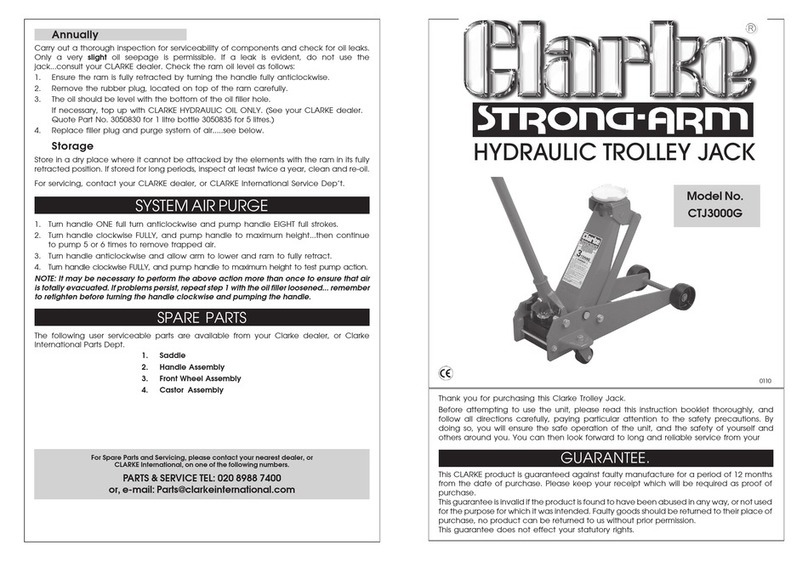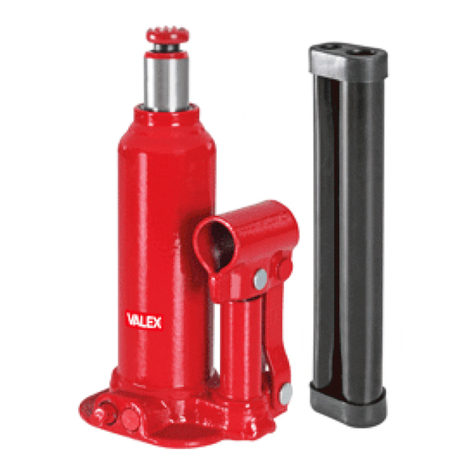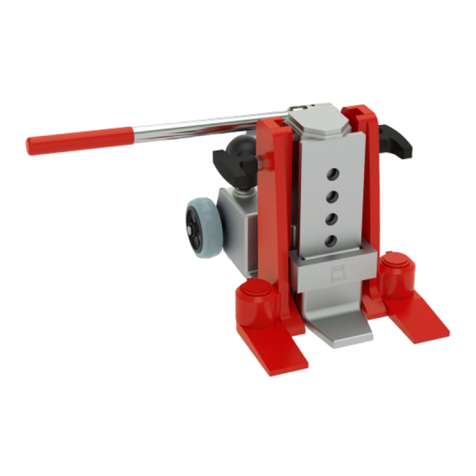
5
DATI TECNICI
Portata max sollevabile 2.000 kg
Altezza massima braccio 330 mm
Altezza minima braccio 140 mm
VERIFICA
All'atto della consegna, verificare la perfetta
integrità del cric. Eventuali contestazioni devono
essere segnalate immediatamente al fornitore.
Il cric idraulico, già completo del suo olio, viene
fornito in robuste scatole di cartone adatte al tra-
sporto e allo stoccaggio. È consigliabile, in caso
di immagazzinaggio, non sovrapporre pesi o altre
scatole sopra lo stesso.
Il trasporto a mano può essere effettuato tramite
l'impugnatura (3 Fig.A).
NORME DI SICUREZZA
FARE ATTENZIONE AL SEGNALE DI PERI-
COLO RICHIAMATO NEL PRESENTE MANUALE.
ESSO SEGNALA SITUAZIONI PARTICOLARMEN-
TE PERICOLOSE.
Nell'utilizzare attrezzature atte al solleva-
mento di pesi, è necessario adottare opportune
precauzioni di sicurezza per ridurre il rischio di
caduta, schiacciamento e lesioni alle persone.
Prima di utilizzare il cric leggere attentamente
e memorizzare le norme di sicurezza. Dopo la
lettura, conservare con cura il presente manuale
in modo che possa durare per tutta la vita del
prodotto stesso.
Non intervenite in alcun modo sulla valvola
di sicurezza (13 fig.A). Non aprite il tappo che
copre la valvola. Qualunque regolazione o
manomissione della valvola modifica le ca-
ratteristiche di sicurezza del prodotto, genera
pericolo e annulla immediatamente la garanzia.
- Indossare adeguati dispositivi di protezione
individuali (scarpe, guanti...)
- Mantenere pulita e in ordine la zona di lavoro.
Aree sporche e in disordine favoriscono il veri-
ficarsi di incidenti.
- È vietato l'utilizzo in condizioni climatiche estre-
me, all'interno di congelatori o forni, in presenza
di forti campi magnetici.
- È vietato l'utilizzo in atmosfere potenzialmente
esplosive ed aggressive, nelle miniere, nei can-
tieri, nelle navi, nei luoghi di transito veicolare e
pedonale.
- È vietato il sollevamento di persone, animali,
liquidi e materiali potenzialmente pericolosi
(metalli fusi, acidi, materiali irradianti, materiali
fragili...).
- Prima di iniziare il lavoro, controllare la perfetta
integrità dell'attrezzatura, che non vi siano
elementi danneggiati o rotti e che la leva di
sollevamento sia stata correttamente inserita
nella sua sede (Fig. C). Le parti che risultassero
danneggiate o rotte devono essere riparate o
sostituite da personale competente e autoriz-
zato. Riparare, o far riparare da personale non
autorizzato dalla Ditta Costruttrice significa, oltre
a perdere la garanzia, operare con attrezzature
insicure e potenzialmente pericolose.
- Durante l'uso del cric non togliere le protezioni
e non introdurre mani o piedi tra il braccio di
sollevamento e il corpo cric.
- Non utilizzate il cric come appoggio posando su
di esso carichi. Effettuate unicamente operazioni
di sollevamento agendo sulla apposita leva.
- Durante le operazioni sorvegliate il cric il carico e
tutti i movimenti.
- Si fa assoluto divieto di far toccare o utilizzare il
cric a bambini e a persone estranee, inesperte
o non in buone condizioni di salute.
- Usare il cric su superfici piane, compatte, in
grado di sopportare il peso del cric e del carico
stesso.
Prima di sollevare un autoveicolo è assolu-
tamente obbligatorio inserire il freno di stazio-
namento e bloccare le ruote che rimangono a
terra con dei ceppi. Inoltre leggete le istruzioni
del veicolo che vi accingete a sollevare.
Dopo il sollevamento del carico, inserire
sotto di esso appositi cavalletti di sicurezza per
evitare eventuali cadute o instabilità del carico.
- Non usate il cric per mantene il carico solle-
vato, ma solo per alzare e abbassare il carico.
- Per la vostra incolumità, non operate sotto il
carico.
- Non usare il cric per sollevare pesi instabili e/o
oltre la sua portata (vedere «Dati tecnici»).
- In caso di caduta accidentale del cric, verificarne
l'integrità.
- Non esporre il cric alla pioggia, alle intemperie
e non usarlo in ambienti umidi o bagnati.
- Durante l'uso del cric, tenere lontani bambini,
estranei e animali nell'area di lavoro. Delimitate




























